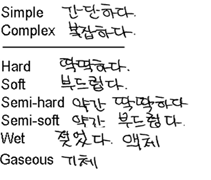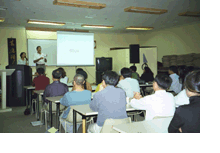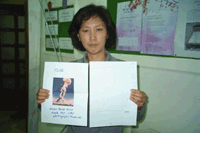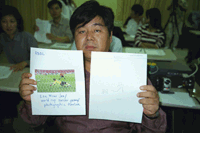 |
|
 |

FEATURE STORY
One Day Wonders
KOREAN REMOTE VIEWERS
LEARN FAST
By Dick Allgire
 The basic training in Hawaii Remote Viewers’ Guild methodology takes six months. The Koreans wanted to learn as much as they could in one day. The basic training in Hawaii Remote Viewers’ Guild methodology takes six months. The Koreans wanted to learn as much as they could in one day.
Would it be possible to teach anything meaningful in a short one-day workshop? I was reluctant to try at first. I was scheduled to deliver a presentation on remote viewing at the New Science Symposium in Seoul, Korea on September 29th. The organizers were urging me to hold a workshop to introduce remote viewing in Korea. But they only had one day available. HRVG methodology is simply too complex to grasp, understand, and practice in a single day. And to make things even more difficult the training would be conducted through a translator, to Koreans with little or no English and no prior exposure to remote viewing. I was not sure some of the terminology would even translate easily. My Korean/English dictionary had nothing under the heading “Spontaneous Ideogram.”
I began plotting an approach. Teaching Visual Ideogram (first step in Stage 1) was certainly possible, but would not fill an entire day. Spontaneous Ideogram and probing skills requires students to memorize a litany of terms. For non-English speaking students to grasp and recite them all would be simply too tedious. An entire day could be spent wrestling with the most basic low level data. Is the target complex or simplex? Manmade or natural? Static or dynamic? Not enough bang for the buck. I wanted the novice remote viewers to produce something more dramatic.
My inspiration came from Mindazzle. Designed by Ed Dames, Mindazzle is sort of a remote viewing parlor game that features preformatted cards, which allow novices to experience non-local awareness without a lot of work or memorization. I had impressed some friends with Mindazzle. Or rather my friends had impressed themselves with the game.
With the realization I could not turn out trained remote viewers in a one-day workshop, I set out to at least allow students to have the first hand experience of non-local awareness. I designed a streamlined and modified version of HRVG Stage One protocols.
Visual Ideogram is pretty easy. The viewers are trained to look on Blackboard and obtain visual imagery of the target. I trimmed some of the page headings so all they would have to do would be write their name and target ID. I also simplified things by preparing 4 letter ID’s rather than the standard 8, making it easier for those not comfortable with the English alphabet.
 For Spontaneous Ideograms/Probes I preformatted special sheets translated into Korean so that the students could produce ideograms and them probe them using multiple choice printed answers. For Spontaneous Ideograms/Probes I preformatted special sheets translated into Korean so that the students could produce ideograms and them probe them using multiple choice printed answers.
 And for the Playfair data collection matrix I again preformatted the matrix with visual symbols; a picture of an eye for SIGHTS, an ear for SOUNDS, a nose for SMELLS/TASTES, a picture of a thermometer for TEMPS, and a hand with touching finger for TEXTURES. And for the Playfair data collection matrix I again preformatted the matrix with visual symbols; a picture of an eye for SIGHTS, an ear for SOUNDS, a nose for SMELLS/TASTES, a picture of a thermometer for TEMPS, and a hand with touching finger for TEXTURES.
I spent much of the day before the workshop going over terms, explaining remote viewing, and getting to know my interpreter. So much would depend on her. Each and every concept, every command would have to pass from my mouth to her ears, be understood by her brain, translated into Korean, spoken by her and transmitted to the students.
 At 10 AM on September 30th twenty four eager, intelligent, bright -eyed Koreans sat down at their desks and looked up at me, waiting to learn the secrets of “Won Kyuk Tooshi” or Remote Viewing. At 10 AM on September 30th twenty four eager, intelligent, bright -eyed Koreans sat down at their desks and looked up at me, waiting to learn the secrets of “Won Kyuk Tooshi” or Remote Viewing.
 The instruction was a bit cumbersome. I would give about 3 sentences worth of instruction, then the interpreter would translate my instructions into Korean. Likewise, questions and comments from the class had to go through the translator. At times I would get excited and ramble on until the translator would tug at my shirt sleeve and beg me to stop- she couldn't process it in large chunks. But she did a wonderful job. The instruction was a bit cumbersome. I would give about 3 sentences worth of instruction, then the interpreter would translate my instructions into Korean. Likewise, questions and comments from the class had to go through the translator. At times I would get excited and ramble on until the translator would tug at my shirt sleeve and beg me to stop- she couldn't process it in large chunks. But she did a wonderful job.
The students came well dressed, many in suit and tie. I immediately encouraged them to be comfortable. I was wearing slacks and golf shirt, and I told them to take off their coats and ties, unbutton their top buttons and get casual. This is important I explained, because you don't want anything to physically interfere with the task of remote viewing. Remote viewing requires you to ignore your immediate physical surroundings and project your awareness elsewhere. You have to be comfortable.
After the introduction and first block of instruction I gave them their first target. In HRVG methodology there is a cadence to the instructions. Like a drill sergeant he teacher barks out commands (known as “The Patter”) while the students follow the commands in unison. This is done to keep the students moving fast, to keep their conscious mind occupied. The instructions begin:“On a clean sheet of paper, in the upper left hand corner, write the word IDEOGRAM. Sliding across to the upper right hand corner, write your name . . . .”
The cadence didn't work. As I issued the commands there was an uncomfortable pause as the interpreter translated my words. Students are allowed to look on Blackboard for no more than 2 to 3 seconds. The timing didn't feel right as my commands went from English to Korean. When I said “STOP!” the translator had to command them in Korean a bit behind my beat.
The first target was as much a learning experience for me as the Korean students. I tried to project confidence and enthusiasm. I was sweating bullets. I quickly looked at 24 pages of data. The target was the Washington Monument. I was looking for tall vertical gestalts. Nothing in the work matched. “It’s okay,” I said. “At first all we are concerned about is whether you learn the protocols, that you become familiar with what to do and when to do it.”
I reviewed the instructions and pulled out another target. This one was a balloon festival in New Mexico. The target photo showed a number of brightly colored balloons taking flight.
Again the painstaking instructions translated into Korean, attempting to keep a proper rhythm and cadence. When they finished I walked around the room scanning pages looking for images similar to the target. YES! There is was- a girl on the front row drew the exact shape of the balloon. Another student and yet another in the back of the class drew the same shapes as pictured in the target photo. I held up the examples for the class to see. Now their faces softened, smiles and nods of understanding. I relaxed a bit, finally confident that this short class might work.
As an instructor you naturally want your students to do well. One student had approached me during my presentation the previous day. His English was good and I had a nice conversation with him. I immediately liked him. In the workshop I was pulling for him to do well. As we worked the first 3 or 4 targets I went back and looked at his work. He was apparently trying too hard, his drawings off the mark. Finally he produced a visual ideogram that was undeniably good target data. I was so happy to hold up his work for the whole class to see.
The best part of the day was when my translator watched the students produce amazing work. She was a witness to something amazing. She took me aside and said, “How can this be? Look at me! I have goose bumps when I see this!”
My wife is Korean so I am quite familiar with the Korean work ethic. When there is a job to be done Koreans will attack it with single minded intensity. I have taught Americans and they tend to start squirming in their seats, fiddling with things and losing their attention span after an hour or two. The Koreans were right there with me, focused and intent even after 6 hours. Six hours of having to listen through a translator.
Every hour and a half or so the translator and I needed a break. The students also needed time off. Learning to communicate with your subconscious is very tiring. I'd tell the students to have some tea or juice, stretch and relax. At every break some of them would approach me and ask questions. They wanted to soak up everything they could about remote viewing.
In Hawaii Remote Viewers’ Guild classes held in Hawaii we find that students are usually good for 3 to 4 targets a day. After that they simply run out of psychic energy. I gave the Koreans a dozen targets. I could sense their fatigue as the afternoon wore on, but the best work of the day actually came on the last target.
The session of the day was produced by Moon Kwang Ryul. It was what we call a “million dollar” sketch. American skeptic (debunker) James Randi has a standing one million dollar prize for anyone who can prove paranormal or psychic ability. Often in class at the Hawaii Remote Viewers’ Guild work is produced that – if the offer were fair and Mr. Randi could see the work- would win the million dollars. Moon Kwang Ryal did a “million dollar” session on the final target of the day.
I had a stack of manila envelopes with target photos sealed inside and target ID’s written on the outside. I alone knew the contents. I selected and cued the targets and no one on earth had access to the sealed envelopes. The students were given only the 4 letter target ID. I gave out the last target ID and watched the students work for 15 minutes. Then I looked at their work. The work produced by Moon Kwang Ryul was a drawing of a person kicking a ball toward a net. Even after years and years of participating in remote viewing and teaching it I looked at his drawing and stopped dead in my tracks.
(Note: I sent a copy of this to a Korean publication and the translator wrote to me asked “What does this mean: ‘stopped dead in my tracks?’” I explained the concept and he got back to me with the Korean saying: "We call it 'my breath seems to stop in surprise’." Well when I saw the drawing my breath DID seem to stop in surprise.)
I had to think for a moment- could he have seen the target photo before doing his work? No, it was still sealed in the envelope. I pulled out the photograph and held it up. It showed a moment from the world cup soccer match, a soccer player kicking the ball toward the net. Moon Kwang Ryul had perfectly drawn the target in his first Visual Ideogram. A million dollar session. I took out the target photo and held it up along with his Visual Ideogram of the man kicking the ball toward a net. I shook Moon Kwang Ryul’s hand and the class began applauding. It was a great a moment.
The HRVG method relies heavily on acquisition of visual data. The bulk of what I taught the Koreans was how to realize visual imagery from the target. Remote VIEWING.
They succeeded.
 
I credit first the methodology, the amazing sequence of instructions and protocols developed by Dr. Richard Ireland and refined by Special Forces Intelligence. I also credit the so-called “first time effect.” People are naturally psychic and are able to produce data at first in spite of themselves. And I also give a great measure of credit to the mindset of the Koreans. They are intelligence, tenacious, focused, and disciplined.
They were real one-day wonders.
Here are some examples of the work produced by the Korean students after just a few hours of instruction:
Balloons
Stealth One
Stealth Two
A-Bomb One
A-Bomb Two
Soccer

 PRINT THIS ARTICLE PRINT THIS ARTICLE
Privacy Statement
Copyright © 2002, H.R.V.G.
All rights reserved.
|
 |
|
  

NOVEMBER-DECEMBER ARTICLES

·New Science Symposium

·Clairvoyance Trials

·Andrew Michrowski

·Conversations

·Stealth RV
|


